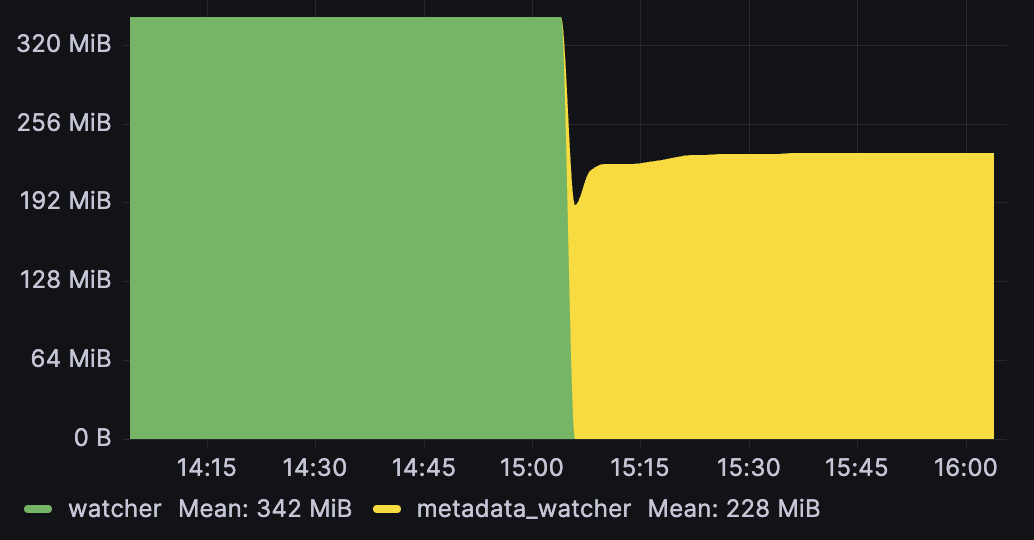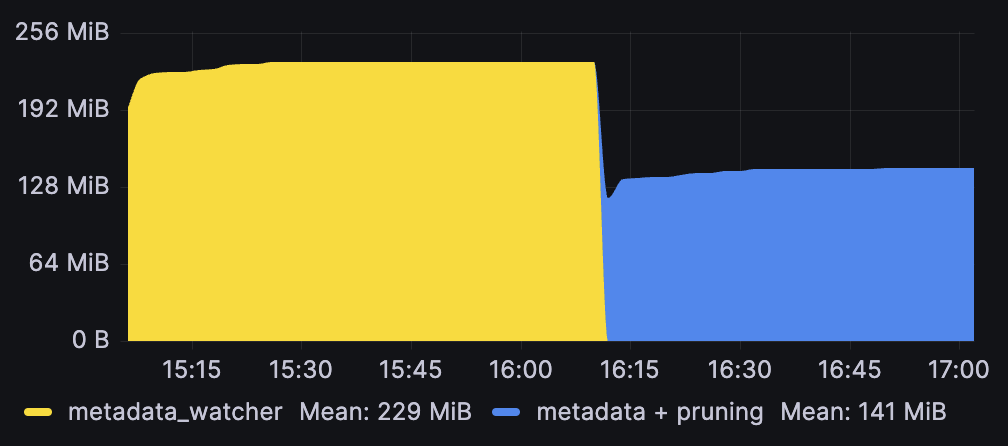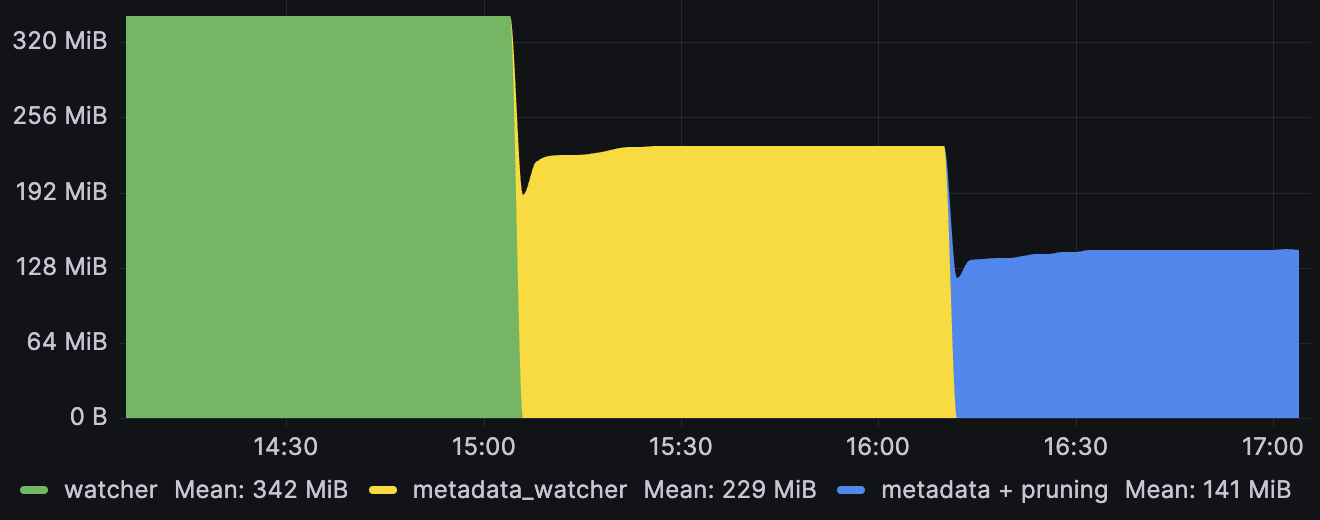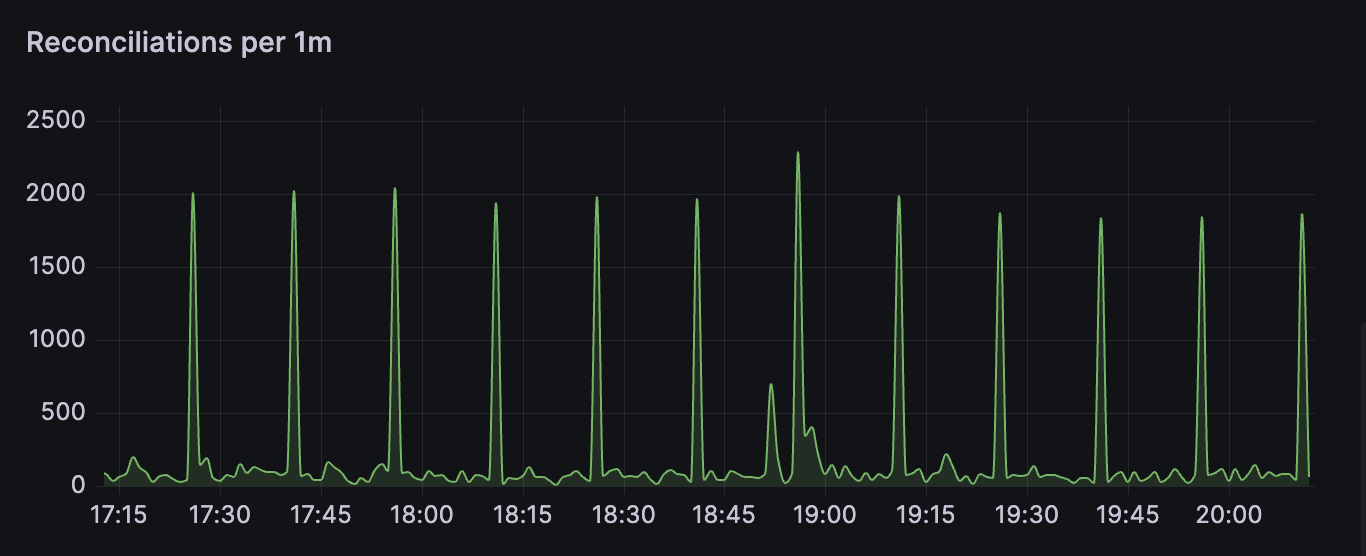Optimization#
This document aims to help optimize various factors of resource consumption by controllers, and it will effectively be a guide on how to reduce the usage of your watcher streams to simplify things for downstream consumers.
Watcher Optimization#
One of the biggest contributor to activity in a Controller is the constant, long-polling watch of the min object and every related object by the use of multiple watcher streams created with some variant of:
let cfg = watcher::Config { RESTRICTIONS };
let stream = SOME_WATCHER(cfg).SOME_MODIFICATION();
By default, watcher streams are implicitly configured within the Controller, but using the controller streams interface outlined in the streams chapter, you can customize every aspect of these streams.
The central premise herein is that controllers benefit from customizing the input streams and we will show how to do these configurations.
Streams Interface Required
The watcher optimizations here that directly call watcher / metadata_watcher require the unstable streams interface to interface with controllers.
Better watcher configuration primarily aim to reduce IO or networked traffic. However, when used in combination with reflector caches, they also become memory optimizations.
Reducing Number of Watched Objects#
The default watcher::Config will watch every object in the Api scope you configured:
Api::namespacedorApi::default_namespaced-> all objects in that namespaceApi::all-> all cluster scoped objects (or all objects in all namespaces)
This is easiest to do with label selectors of field selectors.
Field selectors can be used to filter on certain common properties:
let cfg = watcher::Config::default().fields(&format!("metadata.name={name}"));
And allows explicitly excluding lists of namespaces:
let ignoring_system_namespaces = [
"cert-manager",
"flux2",
"linkerd",
"linkerd-jaeger",
"linkerd-smi",
"linkerd-viz",
"gatekeeper-system",
"kube-node-lease",
"kube-public",
"kube-system",
]
.into_iter()
.map(|ns| format!("metadata.namespace!={ns}"))
.collect::<Vec<_>>()
.join(",");
let cfg = watcher::Config::default().fields(&ignoring_system_namespaces);
Field Selector Limitations
Due to field-selector limitations, you cannot filter on arbitrary fields, nor can you do set operations, forcing explicit negative enumeration as one of the few helpful tricks.
A more general solution involves explicitly labelling the objects you care about, and using the much more expressive label selectors instead:
let cfg = Config::default().labels("environment in (production, qa)");
Backoff on Errors#
Implicitly created controller streams are always created with a DefaultBackoff Backoff implementation (from backoff) similar to the defaults set by client-go to avoid hammering the apiserver when errors occur.
Use backoffs
A watcher that does not call .default_backoff() or setup any other form of .backoff(b) will continuously loop on errors. This generally spams your logs/traces, and can starve your controller and your apiserver of resources. On newer Kubernetes versions, such behaviour can get you throttled.
When going from implicit controller streams to manually created streams, remember to add .default_backoff() at some point in the stream chain:
let stream = watcher(api, cfg).default_backoff();
Watching Metadata Only#
If you do not need all the data on the resource you are watching, then you should consider using the streams#Metadata-Watcher to reduce the amount of data being handled by your watch stream.
Metadata is generally responsible for a small amount of the total object size, so you can often expect a commensurate reduction in incoming bandwidth by only watching metadata. When these watches are sent through a reflector they will also significantly reduce the reflector memory footprint:

Note that this memory reduction can also be achieved through #pruning-fields - and you can potentially omit even more data that way by combining the approaches - but pruned data is still sent on the wire.
There are three pathways to consider when changing controller inputs to metadata watchers:
1. Changing Associated Streams#
When watching an associated stream (via relations) that is only used for mapping and not stored.
If you are using normal watchers for these, then there is potentially a lot of unused data go on the wire. Controller::owns_stream should use metadata_watcher in general (ownerReference lookup only needs metadata), and Controller::watches_stream can also do this if its lookup is based on metadata properties. See streams#input-streams.
2. Changing Primary Streams#
When only metadata properties are acted on (e.g. you have a controller that only acts on labels/annotations or similar).
In this case you can replace the streams#main-stream for a significant memory reduction from the mandatory reflector. Do note the caveat that this changes the type signature of your reconciler slightly.
3. Changing Predicated Primary Streams#
When running a controller with predicate_filters to limit the amount of reconciler hits, and simultaneously not using the cache for anything important.
In this case you can actually also follow the streams#main-stream pattern and call Api::get on the object name when the reconcile function actually calls so you get an up-to-date object. Remember that if you are using predicates on the long watch, then you can quickly discard many changes without requiring all of the data being transmitted.
Such a setup can involve running the metadata watcher with the cheaper/less consistent any_semantic because your reconciler only happens every so often, but when it does, you will do the work properly:
let deploys: Api<Deployment> = Api::all(client);
let cfg = watcher::Config::default().any_semantic();
let (reader, writer) = reflector::store();
let stream = reflector(writer, metadata_watcher(api, cfg))
.default_backoff()
.applied_objects()
.predicate_filter(predicates::generation);
Controller::for_stream(stream, reader)...
async fn reconcile(partial: Arc<PartialObjectMeta<Deployment>>, ctx: Arc<Context>) -> Result<Action, Error>
{
// if we are here, then we have a changed generation - fetch it fully
let api: Api<Deployment> = Api::namespaced(partial.namespace(), ctx.client.clone());
let deploy = api.get(&partial.name_any()).await?;
unimplemented!()
}
This will also help avoid #Repeatedly Triggering Yourself.
Reduce the List Spike#
Every permanent watch loop setup against kube-apiserver generally requires an initial listing of objects (usually in the form of a list api call), followed by a long watchstarting at the given resourceVersion from the initial list. On big clusters this listing was until recently quite memory intensive (for both the apiserver and the controller).
Pagination for this initial list was added for 0.84.0 - with a new default default page size matching client-go's 500. This can be reduced further when working on large objects if needed:
let cfg = watcher::Config::default().page_size(50);
A more efficient alternative was added in 0.86.0 and avoids paging entirely using the streaming WatchList feature. This is supported through Config::initial_list_strategy, and can be sanity tested in the pod_watcher example on a cluster with the feature gate enabled.
let cfg = watcher::Config::default().streaming_lists();
Both these methods should reduce the peak memory footprint of both the apiserver and your controller at the times the controller needs to do a re-list.
Reflector Optimization#
Unless you have another large in-memory cache or other similar memory users in your controller, the primary contributor to your controller's memory use is going to be the mandatory reflector for the main object as well as any other optional reflectors for related objects.
The memory usage of reflectors is directly proportional to how much stuff you put in it, and can be minimized by tweaking a number of properties:
- Amount of objects watched (
watcher::Config) - Asking for only metadata (
metadata_watcher) - Pruning unnecessary fields before storing (
WatchStreamExt)
We have already talked about the first two points (#Reducing Number of Watched Objects and #Watching Metadata Only) above as these have IO benefits for watchers on their own, but also cause memory usage reductions by forcing less stored objects/data.
Pruning Fields#
By default, the memory stored for each object is equivalent to what you get from asking kubectl for all objects matching your ListParams, but additionally asking for --show-managed-fields which kubectl hides from you by default, but is always part of any underlying api based request.
Most controllers do not need to know about the specifics of these, and they should usually be pruned pre-insertion:
let api: Api<Pod> = Api::default_namespaced(client);
let stream = watcher(pods, watcher::Config::default()).modify(|pod| {
// memory optimization for our store - we don't care about fields/annotations/status
pod.managed_fields_mut().clear();
pod.annotations_mut().clear();
pod.status = None;
});
let (reader, writer) = reflector::store::<Pod>();
let rf = reflector(writer, stream).applied_objects();
In the above example we also clear out the status object and annotations entirely pre-storage.
This can be effective, even when already using metadata_watcher, as managed-fields often accounts for close to half of the metadata yaml. Here is the result of clearing only managed fields from a roughly ~2000 object metadata reflector cache:

For reference, here is the full graph showing the effect of first switching from watcher to metadata_watcher (which effectively acts as a smarter way to prune the Spec/Status) on a 2000 object Pod reflector that adds managed field pruning on top:

Except for some of the .metadata properties pruning can generally be done for all the fields you do not care about.
Pruning ObjectMeta
Do not prune everything from ObjectMeta as kube::runtime relies on being able to see .metadata.name, .metadata.resourceVersion, .metadata.namespace and in some cases .metadata.ownerReferences.
Pruning will not reduce your network traffic
All object data passed through a watcher is always ultimately received over the wire from kube-apiserver. Pruning is only local truncation.
Reconciler Optimization#
The reconciler is generally the entry-point for your business logic, so we cannot give too much blanket advice on optimizing this, but we can give a few pointers.
Note that instrumenting standard metrics (observability#what-metrics) on your reconciler, and sending traces of more complicated microservice interactions to a trace collector (observability#instrumenting) are good observability practices, and can go a long way in identifying performance issues.
Repeatedly Triggering Yourself#
AKA the problem that you will most easily run into; a reconciler that modifies the status (say) of its main object will cause a change in that object that is picked up by the Controller's watcher loop, and will be fed back into the reconciler.
This is normally not a problem, because if your status patch that causes this change is idempotent, it will only happen once. The problem is when you start putting non-deterministic values inside the the .status resource (e.g. timestamps rather than hashes).
In such cases, the controller will spin forever on such objects.
Detecting spinlocks
Spinlocks are usually noticeable quickly by just running the controller locally and watching logs for one object, or having a plot graph on your reconciler rate (observability#what-metrics) in grafana. You should expect about 1 to 5+ reconciles every 1/(your requeue time) growing with the number of affected objects and self-interaction.
The two ways to avoid reconciler re-triggering are:
- don't patch in non-deterministic values to your object (breaks idempotency)
- filter out changes to irrelevant parts of your object
These approaches are both recommended because they both have independent merits;
- idempotency is good, and it avoids the spin problem the "good practice way"
- early filtering can allow for more precise reconcile bypasses with less code complexity, and allow opt-in non-determinism (such as timestamp fields)
Watch events can be filtered out early using predicates with WatchStreamExt::predicate_filter, and passing on these pre-filtered streams to controllers:
let deploys: Api<Deployment> = Api::default_namespaced(client);
let changed_deploys = watcher(deploys, watcher::Config::default())
.applied_objects()
.predicate_filter(predicates::generation);
Predicates are unstable
Predicates are a new feature in some flux with the last change in 0.84. They require one of the unstable-runtime feature flags.
Debouncing Repetitions#
After kube 0.86 (via #1265) it is possible to debounce to filter out reconcile calls that happen quick succession (only taking the latest). A debounce time can be set on the controller::Config, and will introduce a delay between the observed event and the eventual reconcile call, triggering only after no relevant events have been seen for the debounce period.
Controller::new(pods, watcher::Config::default())
.with_config(controller::Config::default().debounce(Duration::from_secs(5)))
A common example is to lessen the noise from rapid phase transitions of Pod watches (which receives several repeat status updates after initial application). If your controller only treats pods as a watched resource and does not need to react to every status update, then introducing a handful of seconds of debounce time can help reduce reconciler load:

The graph shows how a 5s debounce acts on reconciliation rates for various workloads (via 4 different controllers) in a cluster with ~1500 pods (the last dashed line indicates a deployment of the controller that enabled debounce).
Debounce effect is situational and will slow down responsiveness
As can be seen from the generally completely unaffected other kinds in the above graph, the effect may not benefit all controllers, and a downside is that it will slow down the controller's average response time to changes. A few seconds can be helpful while waiting for other eventually-consistent components, but beyond that you should consider the tradeoff between the consistency loss and the cost of re-running.
See the documentation for controller::Config for more information.
Reconciler Concurrency#
The controller will schedule different objects concurrently. For example, for the event queue ABA, we'd currently schedule object A and B to reconcile concurrently, and start the second reconciliation of A as soon as the first one finishes. Our guarantee here is that kube will never run two reconciliations for the same object concurrently. This means that default kube behaviour is infinite concurrency whereas controller-runtime has no default concurrency.
On large datasets, spiky workloads can occur with this default. Big datasets being funnelled through the watcher and into the reconciler can cause large amount of work, and when using consistent requeue times, that same spike is likely to show up later:

To flatten such a workload curve, consider limiting your concurrency to control how much work can happen at the same time.
Controller::new(pods, watcher::Config::default())
.with_config(controller::Config::default().concurency(3))
Reconciler Deduplication
Multiple repeat reconciliations for the same object are deduplicated if they are queued but haven't been started yet. For example, a queue for two objects that is meant to run ABABAAAAA will be deduped into a shorter queue ABAB, assuming that A1 and B1 are still executing when the subsequent entries come in.
Future Optimizations#
Not everything is possible to optimize yet. Some tracking issues:
Summary#
As a short summary, here are the main listed optimization and the effect you should expect to see from utilising them.
| Optimization Type | Target Reduction |
|---|---|
| metadata_watcher | IO + Memory |
| watcher selectors | IO + Memory |
| watcher page size | Peak Memory |
| reconciler concurrency | Peak Usage |
| pruning | Memory Usage |
| predicates | Memory + Code Size |
It is important to note that most of these are watcher tweaks.
The target reductions above can all be granted by passing more precise streams to your controller, or by tweaking controller input parameters.